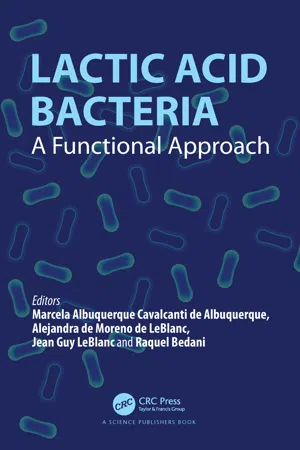
Lactic Acid Bacteria
A Functional Approach
Marcela Albuquerque Cavalcanti de Albuquerque, Alejandra de Moreno de LeBlanc, Jean Guy LeBlanc, Raquel Bedani, Marcela Albuquerque Cavalcanti de Albuquerque, Alejandra de Moreno de LeBlanc, Jean Guy LeBlanc, Raquel Bedani
- 292 pagine
- English
- ePUB (disponibile sull'app)
- Disponibile su iOS e Android
Lactic Acid Bacteria
A Functional Approach
Marcela Albuquerque Cavalcanti de Albuquerque, Alejandra de Moreno de LeBlanc, Jean Guy LeBlanc, Raquel Bedani, Marcela Albuquerque Cavalcanti de Albuquerque, Alejandra de Moreno de LeBlanc, Jean Guy LeBlanc, Raquel Bedani
Informazioni sul libro
Lactic acid bacteria (LAB) are a diverse group of bacteria that comprise low GC content Gram-positive cocci or rods that produces lactic acid as the major end product of the fermentation process. Bifidobacterium genera may also be considered as a part of the LAB group for possessing some similar phenotypical characteristics despite the higher GC content. The key feature of LAB metabolism is efficient carbohydrate fermentation. This contributes to the production of several microbial metabolites that result in the improvement of flavor and texture of fermented foods, in addition to its positive impact on the human health when LAB is administered as a probiotic.
The book deals with advances made in the functionalities of LAB, such as their effect on vitamin D receptor expression, impact on neurodegenerative pathologies, production of B-vitamins for food bio-enrichment, production of bacteriocins to improve gut microbiota dysbiosis, production of metabolites from polyphenols and their effects on human health, effect on reducing the immunoreaction of food allergens, as biological system using time-temperature to improve food safety, and the use of probiotics in animal feed. The book also reviews the use of LAB and probiotic technologies to develop new functional foods and functional pharmaceuticals.
Domande frequenti
Informazioni
1
Cell-Cell Communication in Lactic Acid Bacteria
Potential Mechanisms
Lactic Acid Bacteria
Emails: [email protected]; [email protected]; [email protected]
Email: [email protected]
Quorum Sensing in Bacteria
QS system | Signaling molecule | Bacterial group | Reference |
AI-1 | Many types of acyl homoserine lactones (AHLs) which vary in acyl chain length (4 to 18C) and substitution on C3 (H, OH, or O) | Gram-negative | Fuqua and Greenberg 2002 |
AI-2 | Furanosyl borate diester or (2R,4S)-2-methyl-2,3,3,4-tetrahydroxytetrahidrofuran | Gram-negative and Gram-positive | Park et al. 2016 |
AI-3 | Aromatic aminated, but final structure has not yet been elucidated | Salmonella, E. coli | Kendall and Sperandio 2014 |
AIPs | Autoinducer peptides (ex. Nisin A) | Gram-positive | Kleerebezem 2004 |
PQS | 2-heptyl-3-hydroxy-4-quinolone | Pseudomonas aeruginosa | Heeb et al. 2011, Allegretta et al. 2017 |
HAQs | Hydroxyl-2-alkyl-quinolines or 2-alkyl-4(1H)-quinolones | Pseudomonas aeruginosa | Heeb et a... |